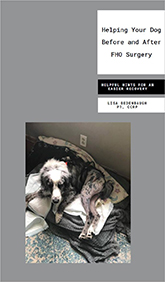K9 HipLign™
The K9 HipLign™ is currently sold through CRS while undergoing its own website makeover — but you’re still getting the same awesome product and customer support from the K9 HipLign™ team.
Stay tuned for our big reveal!
Wearable Therapy
The patented K9 HipLign™ is a first-to-market wearable therapy for canine hip dysplasia, particularly for dogs with mild to moderate cases. This form-fitting therapeutic garment is designed to promote improved posture and dynamic stabilization around the hip joints, which can lead to decreased pain and better mobility. Our product has been clinically validated, and results show both reduction in pain and improvement in range of motion. Over 95% of dogs tested have accepted our product at first use!
Get this Free E-book! Helping Your Dog Before and After FHO Surgery -- This guide can help you prepare before surgery,and provides tips to better manage your dog's recovery.
